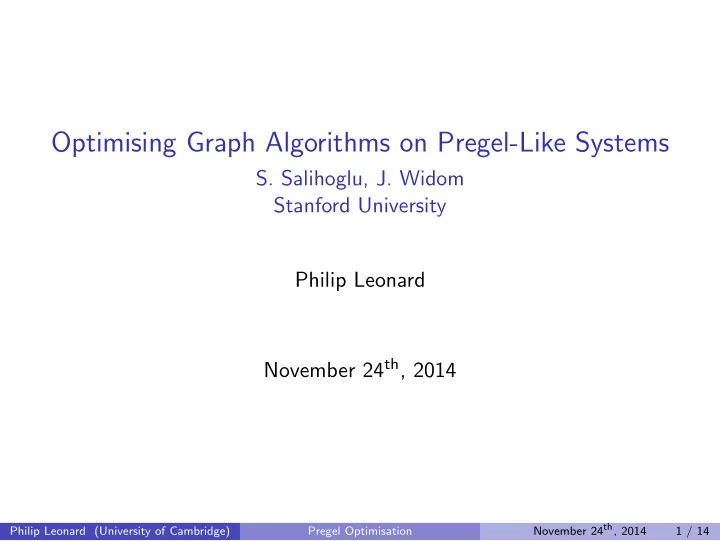

Optimising Graph Algorithms on Pregel-Like Systems S. Salihoglu, J. Widom Stanford University Philip Leonard November 24 th , 2014 November 24 th , 2014 Philip Leonard (University of Cambridge) Pregel Optimisation 1 / 14
Pregel Reminder Bulk Synchronous Parallel model Vertex centric program vertex.compute() Computation unit is a superstep Optional master.compute() for serial computation Vertices receive data from previous superstep, update locally and then broadcast results Open Source implementations; Giraph and GPS November 24 th , 2014 Philip Leonard (University of Cambridge) Pregel Optimisation 2 / 14
Whats Wrong With Pregel? Slow convergence and communication costs Performance reflects graph structure Deals poorly with natural graphs November 24 th , 2014 Philip Leonard (University of Cambridge) Pregel Optimisation 3 / 14
Key Costs Communication Number of supersteps Memory Computation Optimisations will focus primarily on the first two. November 24 th , 2014 Philip Leonard (University of Cambridge) Pregel Optimisation 4 / 14
The Optimsiations I Finish Computations Serially (FCS) ◮ Slow convergence arises from graphs with structure ◮ FCS reduces convergence time ◮ Can be applied to algorithms where graph “shrinks” ◮ When active graph small enough, final computation is finished serially in master.compute() , and then broadcasts results back to workers Storing Edges At Subvertices (SEAS) ◮ Set of vertices merged to form supervertices ◮ In SEAS, subvertices are kept alive and they retain adjacency matrices ◮ Increases communication between sub and supervertices, but reduces computation (runtime) November 24 th , 2014 Philip Leonard (University of Cambridge) Pregel Optimisation 5 / 14
The Optimisations II Edge Cleaning On Demand (ECOD) ◮ Pregel deletes edges in a superstep ◮ ECOD deletes ‘stale’ edges when they are discovered in computation ◮ Eager vs Lazy cleaning Single Pivot (SP) ◮ Some graphs exhibit a single giant component ◮ SP avoids excessive communication ◮ Used to find large components quickly (Useful for finding Strong/Weak Connected Components) November 24 th , 2014 Philip Leonard (University of Cambridge) Pregel Optimisation 6 / 14
The Algorithms Strongly Connected Components Minimum Spanning Forest Graph Colouring Approximate Maximum Weight Matching Weakly Connected Components Most require multiple computation “phases” November 24 th , 2014 Philip Leonard (University of Cambridge) Pregel Optimisation 7 / 14
Strongly Connected Components What it does? Parallel colouring algorithm for finding strongly connected components in a graph. Optimisations Finishing Computations Serially; 1.3x to 2.3x runtime reduction and 26% to 56% reduction in supersteps on webgraphs Single Pivot; 1.1x to 1.2x runtime reduction FCS + SP; 1.45x to 3.7x runtime reduction November 24 th , 2014 Philip Leonard (University of Cambridge) Pregel Optimisation 8 / 14
Minimum Spanning Forest What it does? Minimum Spanning Trees found in disconnected graph components (forest), then merged in supervertex-formation. Optimisations Storing Edges At Subvertices; 1.15x to 3x runtime reduction Plus Edge Cleaning On Demand; 1.9x increase of communication, 1.2x to 3.3x runtime reduction Finishing Computations Serially; Can be applied, but convergence isn’t slow for MSF (supervertex-formation is fast). November 24 th , 2014 Philip Leonard (University of Cambridge) Pregel Optimisation 9 / 14
Graph Colouring What it does? Greedy heuristic for graph colouring problem, iteratively finding Maximal Independent Set in order to colour a graph in as fewer colours as possible. Optimisations Finishing Computations Serially; 1.1x to 1.4x runtime reduction and 10% to 20% reduction in supersteps on .sk webgraph November 24 th , 2014 Philip Leonard (University of Cambridge) Pregel Optimisation 10 / 14
Approximate Maximum Weight Matching What it does? In a undirected weighted graph, Approximate MWM is a 1/2-approximation algorithm to find a set of vertex-disjoint edges with maximum weight Optimisations Edge Cleaning On Demand; 1.45x runtime reduction, 1.3x to 3.1x reduction in communication and 1.7x to 2.2x increase in number of supersteps November 24 th , 2014 Philip Leonard (University of Cambridge) Pregel Optimisation 11 / 14
Weakly Connected Components What it does? Finding maximal subgraphs of a directed graph such that replacing directed edges with undirected edges produces a connected undirected graph Optimisations Single Pivot; 2.7x to 7.4x runtime reduction on all graphs November 24 th , 2014 Philip Leonard (University of Cambridge) Pregel Optimisation 12 / 14
Criticisms Might have benefited from implementing at least one pre-implemented graph algorithm. Couldn’t find a reason for why MWM isn’t tested using FCS, even though it claims to optimise it. Message combiners are placed in related work section? November 24 th , 2014 Philip Leonard (University of Cambridge) Pregel Optimisation 13 / 14
Conclusion Identified a good set of optimisations which appear to work well All algorithms optimised in at least one area if not more These previously unused algorithms might now be feasible for Pregel-like systems Future work might see these optimisations included in a library form for Pregel-like systems November 24 th , 2014 Philip Leonard (University of Cambridge) Pregel Optimisation 14 / 14
Recommend
More recommend